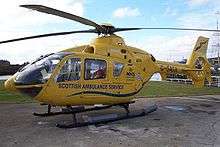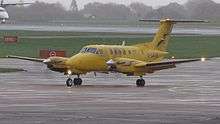Scottish Ambulance Service


The Scottish Ambulance Service (Scottish Gaelic: Seirbheis Charbadan-eiridinn na h-Alba) is part of NHS Scotland, and serves all of Scotland. It is a special health board funded directly by the Health and Social Care Directorates of the Scottish Government.
The two main functions of the trust are the provision of a paramedic-led accident and emergency service to respond to 999 calls and the patient transport service (non-emergency service), which performs the role of taking patients to and from their hospital appointments, discharges from hospital and non-urgent transfers.
History
In 1948 the newly formed National Health Service contracted two voluntary organisations, the St Andrew's Ambulance Association and the British Red Cross, to jointly provide a national ambulance service for Scotland. The service was known as the St Andrew's and Red Cross Scottish Ambulance Service. The Red Cross withdrew from the service in 1967; the service was renamed the St Andrew's Scottish Ambulance Service. In 1974 the service was taken over by the NHS, the title being shortened to the Scottish Ambulance Service.
St. Andrew's First Aid, which is the trading name of St. Andrew's Ambulance Association, continues as a voluntary organisation.
In 2003 there was a reorganisation of the ambulance control centres across Scotland, with eight being merged into three.[1]
Uniform
The original uniform for the service consisted of a light blue shirt, black clip-on tie, navy blue sweater and black peaked cap with Service crest.
In 1992, the uniform changed to a boiler-suit type uniform, to reflect the practicalities of providing front-line emergency care; and eventually a very similar trouser / shirt combination. These uniforms were an Irish green colour for Emergency staff and a light blue shade for Patient Transport staff.
In 2013/2014, the uniform was again changed to mirror the NHS National Uniform standard. It is now supplied by Dimensions and is broadly similar to all other Ambulance Services in the UK; a dark green trouser / shirt combination with associated PPE. All staff, including control centre staff, now wear the national uniform unless otherwise authorised.
Organisation
The national headquarters are in west side of Edinburgh and there are five divisions within the Service, namely:
| Division | Covering | Area in Square Miles | Divisional HQ |
|---|---|---|---|
| North | Highlands, Western Isles, Grampian, Orkney, Shetland[2] | 15,607 | Raigmore Gardens, Inverness, IV2 3UL |
| East Central | Fife, Forth Valley, Tayside[3] | 4,421 | 76 West School Road, Dundee, DD3 8PQ |
| West Central | Greater Glasgow, Lanarkshire[4] | 1,054 | Range Road, Motherwell, ML1 2JE |
| South East | Edinburgh, Lothian and Borders[5] | 2,457 | Kings Haugh, Peffermill Industrial Estate, Edinburgh, EH16 5UY |
| South West | Argyll, Argyll islands, Clyde islands, Ayrshire, Dumfries and Galloway[6] | 6,670 | Maryfield Road, Ayr, KA8 9DF |





Patient Transport
The Patient Transport Service carries almost 1.6 million patients every year. This service is provided to patients who are physically or medically unfit to travel to hospital out-patient appointments by any other means can still make their appointments. The service also handles non-emergency admissions, discharges, transport of palliative care patients and a variety of other specialised roles.
Patient Transport Vehicles come in a variety of forms and are staffed by Ambulance Care Assistants, whom work either double or single crewed. They are trained to look after patients during the journey, and to provide basic emergency care.
Air Ambulance Division
The service has the only government-funded air ambulance service in the UK,[7] operated under contract by Gama Aviation. The fleet consists of two Airbus H145 helicopters[8] (operated under sub-contract by Babcock Mission Critical Services Onshore Ltd.) and two Beechcraft B200C King Air fixed-wing aircraft, which provide emergency response and transfers of patients to and from remote areas of Scotland. In 2015/16, the air ambulance crews flew 3,849 missions. One helicopter and one King Air are based at a Gama Aviation facility at Glasgow Airport. The other operating bases are Inverness Airport (helicopter) and Aberdeen Airport (King Air).[9]
The aircraft based in Glasgow are regularly used by the UK's only Emergency Medical Retrieval Service. The air ambulance service was occasionally featured as part of the popular Channel 5 television documentary series Highland Emergency.
Charity-funded air ambulance
In late 2012 a charity was founded to provide a further air ambulance, based at Perth Airport, to work alongside the state-funded aircraft.[10] Scotland's Charity Air Ambulance (SCAA) commenced operations in May 2013 with a Bolkow 105 airframe. Since November 2015, SCAA operates a Eurocopter EC-135 helicopter.[11] The helicopter is crewed by Scottish Ambulance Service paramedics, tasking is from the SAS ambulance control centre at Cardonald.
Special Operations Response Team (SORT)
In 2010 the service established three teams of specialist accident & emergency ambulance personnel who were given specialist training.[12] This £4.3 million initiative was to provide additional preparedness to be able to respond to large-scale hazardous incidents, such as those that might involve chemical, biological, radiological or nuclear material. The work was in concert with the UK government.
As of 2016 there are five SORT teams, three full-time and two on-call. These teams provide a specialist response to major incidents, and provide paramedic care in hostile environments. The team provides capability in arenas such as water rescue, safe working at height, search and rescue including the use of breathing apparatus, and confined space working. The SORT teams also provide a full-time emergency decontamination and inner-cordon capability. The full-time SORT teams also provide specialist support to police firearms teams, using ballistic protection to provide care to casualties in a live-fire zone.[13]
Ambulance Control Centres
The Scottish Ambulance Service operates three Ambulance Control Centres (previously known as EMDCs until June 2012) which provide command & control and 999 call taking facilities for the Service; these are located in Cardonald, South Queensferry and Inverness. These centres operate 24 hours per day 365 days per year and are staffed by Emergency Call Handlers, Emergency Medical Dispatchers and Clinical Advisors.[14] All requests for an ambulance are prioritised using software called the Advanced Medical Priority Dispatch System (AMPDS) and a response is generated according to clinical need. Responses can be in the form of an ambulance, a Paramedic Response Unit, a BASICS Doctor, Emergency Medical Retrieval Service, an Ambulance Officer or a Community First Responder.
Training Academy
The Service has its own dedicated training academy within the campus of Glasgow Caledonian University, which opened in June 2011.[15] The facility has purpose built classrooms, lecture theatres, syndicate rooms and a clinical simulation area that recreates a 16-bed hospital ward and Accident & Emergency department allowing realistic interaction with other trainee healthcare professionals.[16]
Prior to April 2011, the service used its own dedicated training college located at Barony Castle in Eddleston near Peebles. Set in 25 acres (100,000 m2) of formal gardens and woodlands, Barony was a residential training and conference centre with 78 bedrooms that allowed the service to carry out all its training in house.
Facts and figures
In 2015/16, the service:[17]
- Responded to 736,906 accident and emergency incidents.
- Carried out 894,691 non-emergency patient journeys.
- Flew 3,849 air ambulance missions.
- The average response time to life-threatening (Cat A) calls throughout Scotland was 7.4 minutes.
- The service employs 4,305 staff, of whom 536 are in support services and administration and 16 are board members.
Ambulance Livery
The ambulances have been painted white since the formation of the Scottish Ambulance Service. The original colour of white was a cream white called "Ambulance White" this has now been replaced by a brighter "Titanium" White. The ambulances originally carried a blue stripe of the sides with "Scottish Ambulance Service" in yellow lettering. The livery was changed to yellow fluorescent stripes sometime between 1986 and 1992. The current livery with Battenburg markings was introduced in 2002.
See also
Other Scottish emergency and non-emergency services:
References
- ↑ Marshall, Chris (6 January 2015). "Thousands of ambulances sent to wrong addresses". The Scotsman. Retrieved 6 January 2015.
- ↑ Locations - North scottishambulance.com, accessed 9 May 2009
- ↑ Locations - East Central scottishambulance.com, accessed 11 February 2009
- ↑ Locations - West Central scottishambulance.com, accessed 11 February 2009
- ↑ Locations - South East scottishambulance.com, accessed 11 February 2009
- ↑ Locations - South West scottishambulance.com, accessed 11 February 2009
- ↑ "What we do: Air ambulance". Scottish Ambulance Service. Retrieved 20 December 2014.
- ↑ "'Technical difficulties' put stop to air ambulance's island tour". STV News. 3 July 2015. Retrieved 8 April 2016.
- ↑ "What we do: Aircraft". Scottish Ambulance Service. Retrieved 2 June 2016.
- ↑ "Perth base for Scotland's charity air ambulance". BBC News. 27 November 2012. Retrieved 8 April 2016.
- ↑ "New helicopter unveiled for Scotland's Charity Air Ambulance". STV News. 30 October 2015. Retrieved 8 April 2016.
- ↑ "Ambulance disaster teams created". BBC News. 11 August 2010.
- ↑ "Working for us:Special Operations Response Team". Scottish Ambulance Service. Retrieved 11 April 2016.
- ↑ "Working for us: Ambulance Control Centre". Scottish Ambulance Service. Retrieved 20 December 2014.
- ↑ "Nicola Sturgeon unveils new Scottish Ambulance Academy at Glasgow Caledonian University". Daily Record. 27 June 2011. Retrieved 8 April 2016.
- ↑ "New Academy is a major milestone for Ambulance professional development" (Press release). Scottish Ambulance Service. 8 Feb 2011. Archived from the original on 2 Feb 2012. Retrieved 12 May 2014.
- ↑ "Scottish Ambulance Service Annual report 2015/16" (PDF). Scottish Ambulance Service. Retrieved 2 Nov 2016.
External links
 Media related to Scottish Air Ambulance at Wikimedia Commons
Media related to Scottish Air Ambulance at Wikimedia Commons Media related to Ambulances in Scotland at Wikimedia Commons
Media related to Ambulances in Scotland at Wikimedia Commons- Official website